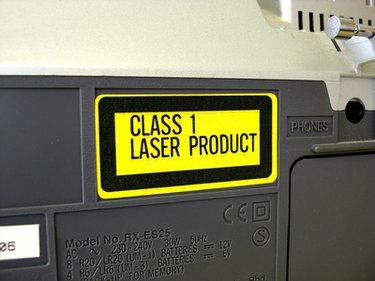
Laser printers generate crisp, clear and repeated images on various materials ranging from paper and cardboard to plastic and metal printing plates. A paper laser printer operates similarly to a copier in that light magnetizes specific areas on a drum, attracting magnetic-colored toner. The toner is then transferred to the paper and fused with a scorching hot roller. The difference between a laser printer and a copier is that the copier uses a light to reflect an image from an original to the drum surface. A laser printer uses a computer-controlled laser to expose the drum in a series of very small, precisely positioned dots. Once the drum is exposed it then picks up toner and transfers it to paper, then the combination is fused.
Resolution
Video of the Day
Laser printer imaging paper can have various resolutions ranging from 300 laser dots per inch (dpi) to up to 1200 dpi. The laser produces smaller and smaller dots for corresponding increases in the number of dots per inch. Laser printer imaging paper rarely has resolutions exceeding 1200 dpi because the physical properties of the toner cannot be reduced to smaller particles.
Video of the Day
As the resolution increases, so does the smoothness and clarity of the printed image. Smaller and smaller dots arranged in curves and gradients result in less jagged edges and more subtle changes in screens. The higher the resolution, the more shades of gray are available. Three hundred dpi laser printers can produce 16 shades of gray, while 1200 dpi printers can produce 128.
Speed
Laser-printer speed is rarely restricted by the mechanical ability to move the paper. Speed is determined by the laser's ability to image the drum for repeated passes. Also, laser-printer speeds are affected by the computing power available to process and translate the image for the laser. Laser printers have processors and random-access memory (RAM), just like the computer used to produce the original file. Some laser printers have hard drives for storing data such as font files and other necessary graphic files. All of these factors can affect the laser printer's speed, measured in pages per minute. A relatively slow laser printer may run at 12 to 16 pages per minute. Faster laser printers can reach speeds of over 60 pages per minute. These machines are used for high-end graphic production such as address mailers and advertising supplements.
Color
Color laser printers work identically to black-only laser printers with one exception. Instead of one drum and one toner, the printer has four: black, cyan (a light blue), magenta (a pinkish red) and yellow. The four lasers image four drums, and the sheet of paper passes each drum separately. Once all four toners are on the paper, it is fused. Color laser printers usually come in only 1200 dpi resolutions in order to produce accurate color. Also, color laser printers run at relatively lower speeds because of the complexity of aligning the paper for accurate color registration and multiple laser and toner operations.